A Slightly Obsessed Genre Special!
OVERVIEW
Back in 2013 I started a weekly, self-imposed discipline of movie write-ups on my Facebook page. My intent—besides meagerly attempting, admittedly, to self-justify half a lifetime of obsessive movie-watching—was to find a format for writing about movies that is both entertaining and informative. Basically, I thought that if I could in any way pique a theoretical reader’s interest in classic movies or movie history, then I would consider the modest venture a rousing success.
Over this four week period, then, I’ll be rolling out the very first from these “series” on classic movies which I’ve here re-named “American Genres.” Identifying four distinct, uniquely homegrown categories of American filmmaking, I trace the chronology—in terms of convention and thematic content, mainly, but also in terms of their historical development—through eight“key” examples from each chosen genre.
While by no means an exhaustive survey or a rigorously-academic analysis, these are rather brief, hopefully engaging and accessible essays—written from the vantage of being a movie ‘enthusiast’ as opposed to a ‘writer’ or ‘critic’—on some of my personal favorite movies.
INTRO: WESTERNS!
Westerns: 1903 – 1950s
Rounding up our discussion of Classic Hollywood movies, I’ll be straight-shootin’ a couple-four classics from possibly our only homegrown genre of filmmaking, The Western. From the earliest days of the American narrative film, and pre-dating all other types of movies, there has been one constant setting to which the imagination of the silver screen has invariably returned: The West.
112 years ago this December, an actor named Justus D. Barnes appeared in a short prologue preceding a movie called The Great Train Robbery.
The ‘shot’—quite literally—consisted of the actor, playing the leader of a frontier outlaw gang, in medium close-up, taking dead aim at the lens of the camera and firing point blank into the audience.
Now, this *may* not have been the first screen close-up, or the first film story set in the even-then remote period of the Wild West, but when the smoke cleared—issuing from the muzzle of the actor’s blank-loaded revolver—not only was a new term for film photography invented (“the shot”), but also a romanticized image for a particular time and place in American History. The Screen Western was born.
The earliest entries, then, will be fairly well-known and representative examples of American myth-making at its finest. ‘Cause, really, that’s what a good Western does: sunset images of sand, sagebrush, and rock formations stretching towards the horizon; the glint of metal spurs, silver belt-buckles, and pearl-inlaid pistol handles galloping past; the dust-clouded thoroughfares down which hip-slung duelists stroll at High Noon—all make-up the motion-visual iconography of America’s lost frontiers and create a mythology out of our past.
I. STAGECOACH (1939, United Artists, dir. John Ford)
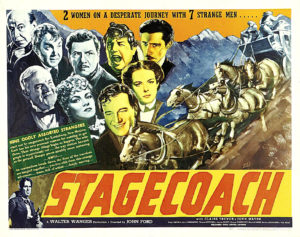 All aboard for Lordsburg! Ladies sit facing forward, please, and gentlemen facing t’other!
All aboard for Lordsburg! Ladies sit facing forward, please, and gentlemen facing t’other!
Well shoot, Curly (George Bancroft), Lordsburg? Ain’t no way we’re gettin’ to Dry Fork, much less Apache Wells, what with Geronimo and the rest of ‘em Apaches on the warpath… Heck, if this ol’ Buck(Andy Devine) makes it over Lee’s Ferry—without’n those reservation jumpers cuttin’ the raft loose afore we even get there—I’ll be a monkey’s uncle.
S’pose it’s a good thing we picked up the Ringo Kid (John Wayne) on the way—even if he’s just busted outta jail—and that gambler dude Hatfield (John Carradine) and his colt revolvers’ll serve in a skirmish, but how ‘bout Doc Boone (Thomas Mitchell)—on whom the sun don’t set without a snootful or three—and that ornery bank feller Gatewood (Berton Churchill)? Or that meek lookin’ reverend-sort with the whiskey samples, Whatsisname (Donald Meek)? Dunno ‘bout you, but that Mrs. Mallory (Louise Platt) sure looks awful pale t’me and Dallas (Claire Trevor) is good ‘nough in her way, though can’t imagine Her Sort mixin’ well with decent folk, such as they are.
Sure grateful to have ya ridin’ shotgun, Curly, but how ‘bouts we just forget the whole thing and turn on back? The cavalry boys behind’ll be headin’ off soon and that young Lieutenant (Tim Holt) sure as heck ain’t gonna break his orders to look out f’r this motley crew longer’n he has to… No? Oh well, worth a try.
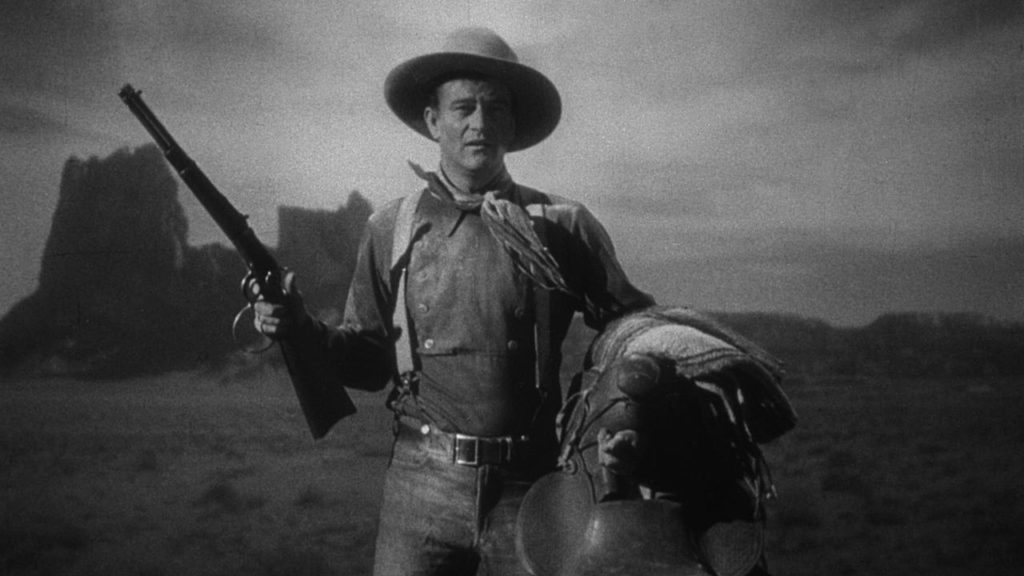
“Well, they’re saved from the blessings of civilization.”
John Ford made Westerns. No other Hollywood director was as closely associated with a particular genre of filmmaking, or as having almost single-handedly shaped the popular imagination regarding a particular time and place in American History, the Old West, than John “I make Westerns” Ford.
Oddly enough, though, when Ford made Stagecoach he actually hadn’t *made* a Western in over 13 years. From his earliest Harry Carey-starring horse operas (Straight Shooting [1917], The Outcasts of Poker Flat [1919]) to his great silent Western Spectacle Epics (The Iron Horse [1924], 3 Bad Men [1926]), Ford made about 50 Westerns between 1917 and 1926… and then, with the coming of sound, the big-budget Western seemed to fall out of favor as a viable commercial form.
Ford, by then undoubtedly the most accomplished filmmaker in Hollywood, went on to make serious dramas, action flicks, comedies, historical epics—even a Shirley Temple musical (1937’s Wee Willie Winkie)—racking up Oscars, critical plaudits, and Babylon-sized offers from just about every major film studio along the way, but had yet to essay the type of story that would fully exploit the visual wonders of the American West and his keen narrative sense for intimate stories told on the broadest of canvasses imaginable.
Enter Stagecoach. Produced independently—after being turned down by every major studio in Hollywood—Stagecoach proved one of Ford’s greatest successes, and an enduring American classic. Relegated the past decade to Poverty Row B pictures and cheap Saturday Matinee serials, the Western had found its Albert Bierstadt by way of Bret Harte in Ford’s painterly eye for overwhelming landscapes—this was the first of his Westerns shot in the appropriately-named Monument Valley—and an epic vision of a country and people forging a civilization out of the wilderness. More than making the Western a commercially viable movie genre once more, Stagecoach raised the Western to the level of art.
And, oh yeah, this was also the movie that made a star out of John Wayne, given one of the more memorable close-ups in movie history: a single-take track-in on the tall, lean 31-year-old screen icon one-arm cocking a Winchester rifle!
II. MY DARLING CLEMENTINE (1946, 20th Century Fox, dir. John Ford)
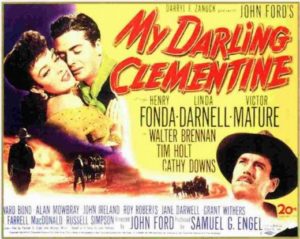 November 1, 1882 issue of “The Deadwood Pioneer,” Editor/Sole Proprietor A.W. Merrick reporting…
November 1, 1882 issue of “The Deadwood Pioneer,” Editor/Sole Proprietor A.W. Merrick reporting…
“Gunfight in Arizona Territory”
1500 miles to the southwest of these Black Hills and a mere 30 miles north of the US/Mexico border lies a boomtown on the edge of silver mines. ‘Tombstone’ is the name given to a cluster of clapboard dwellings, tents, a few stables and several saloons, all surrounding a Grand Hotel erected by the town’s founder.
On Wednesday last, a gunfight broke out in a livery stable on the outskirts of town. This much is known. According to highly variant accounts of the incident in the town’s competing news journals, “The Epitaph” and “The Nugget,” the offending parties, a loose confederation of frontier ‘cowboys,’ advanced upon law officers and their representatives the morning after one of their numbers had been disarmed and fined by an officer who may or may not have been the town’s Marshal.
Reports conflict over the motives for the assault—or, indeed, who had been disarmed, or even the name of the officer who arrested the as yet unidentified assailant—but when the dust cleared on the ensuing fracas—in some reports lasting 5-10 minutes, in others no more than 30 seconds—three of the cowboys lay dead, along with at least one fallen among the party of peace officers. (It should be further noted, however, that reports conflict even on this lattermost account.)
This was a small news item delivered by wire service, but what struck this reporter most upon reading it was the inconsistency of its reportage. It is with some shame that a member of our Fourth Estate must again report that our frontier territories are subject to the whims and vicissitudes of rumor and hearsay. As a distinguished colleague of mine once observed in coverage of a similar event, “When the legend becomes fact, print the legend.” It is epitaph for a wilderness upon which civilization is built, and the crucible upon which nation is forged.
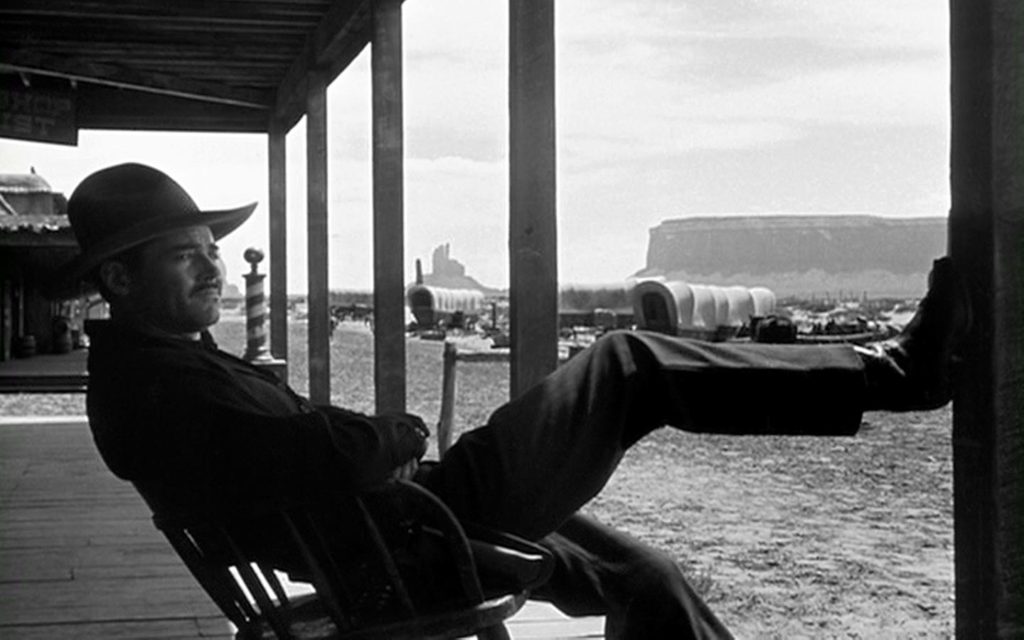
“Ma’am, I sure like that name… Clementine.”
John Ford’s stirring and highly romanticized re-telling of the story of frontier lawman Wyatt Earp (Henry Fonda), tubercular gunfighter Doc Holliday (Victor Mature), and the famous/infamous “Gunfight at the O.K. Corral” is, of course, much more legend than fact. But that’s a little beside the point. The point here is the setting. Like STAGECOACH and every western Ford made subsequent, that setting is the grand vista that anonymously and majestically stands for The West, Monument Valley.
Located in the southeastern portion of Utah, and bordering on Arizona, Ford’s Monument Valley—a vast wilderness of sand, arroyos, and jutting Butte formations—is an overwhelming, almost alien landscape that gives epic scope to the pistol-packing, saddle-sore deeds of those looming shadows horse-galloping through it. What I noticed most in watching this movie the umpteenth time was the sky and clouds hanging over the rugged hills and sand-eroded rock towers: a place where heroes walked among us and which strictly (and accurately) could be known only as God’s Country. Again, it’s a setting that by its very nature and effect announces itself as a magnificent Neverland where myths and legends become truth.
So yeah, the *real* Wyatt Earp was little better than a gambler, extortionist, and occasional pimp—the ‘lawman’ part often came as something of an afterthought. (Heck, he wasn’t even the Marshal in Tombstone! The actual honor of which befell his brother, Virgil.) Indeed, there have been movies attempting to ‘expose’ Earp as the semi-occasional fraud he may well have been—John Sturges’ 1967 Hour of the Gun and 1994’s Kevin Costner-starring Wyatt Earp among them—but revisionism in Westerns is more often than not code for ‘boring.’ As this self-admitted romanticist will confess once more, give me Ford, Henry Fonda, Monument Valley, and their dream vision of the West any ol’ day of the week.
III. THE SEARCHERS (1956, Warner Bros., dir. John Ford)
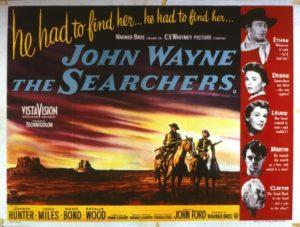 Telegraph dispatch from Appomattox, Virginia; April 15th 1865…
Telegraph dispatch from Appomattox, Virginia; April 15th 1865…
A band of Texas volunteers for the Confederacy numbering, according to varying accounts, 10-15 refused to surrender their sabers or firearms to Union officials. In the resulting skirmish, 3 army officers lay dead, with one Texican answering to a tall and spare description sustaining serious injury to his leg above the knee. The suspects, escaped, should be considered armed and dangerous.
United States Army General Phil Sheridan, in private correspondence; February 1866…
In holding the line above the Rio Grande to the encroaching French hordes, one volunteer—surely an outlaw in our late conflict from the sovereignty of our nation—showed great valor in repeatedly crossing the Mexican border in order to supply Juarez’s forces with guns and provisions. In recognition of his bravery, I shall be nominating this unnamed soldier—for name he will not give—for Medal of Honor.
Telegraph dispatch from John T. Chance, Sheriff of Rio Bravo; December 17th 1866…
A band of cowboys wearing sackcloth over their heads and armed with army-issue Winchester rifles busted into the First Bank of the Rio Bravo in the early hours of the evening and rode off with 10,000 dollars in gold. The leader of the gang is tall, walks with a pronounced limp, and may or may not answer to the name “Edwards.” My deputies gave pursuit, but the company quickly crossed the Mexican border on stolen horses.
Wells Fargo private dispatch to Bank of New York; August 3rd 1867…
A steel-lined wagon carrying 20,000 dollars in newly-minted gold pieces was detained and relieved of its cargo this morning by a band of unidentified outlaws. The band, numbering between 5 and 7, is thought to be the same group of ex-Confederate soldiers who have been terrorizing the wilds of west Texas with daring daylight robberies.
United States Cavalry General Jeffrey T. Greenhill official dispatch to Washington Office of Indian Affairs; March 7th 1868…
Scalphunters along the U.S.-Mexican border have become a veritable scourge to any efforts on the parts of the U.S. Cavalry to pacify the warring elements of the Indian Nations. Most recently, a Comanche village was picked apart, set fire to—its women and children brutally murdered—in such cold-blooded and precise fashion as to suggest the work of specialists. Survivors described “El Hombre Alto,” or “The Tall Man,” as a particularly merciless agent of savagery and violence.
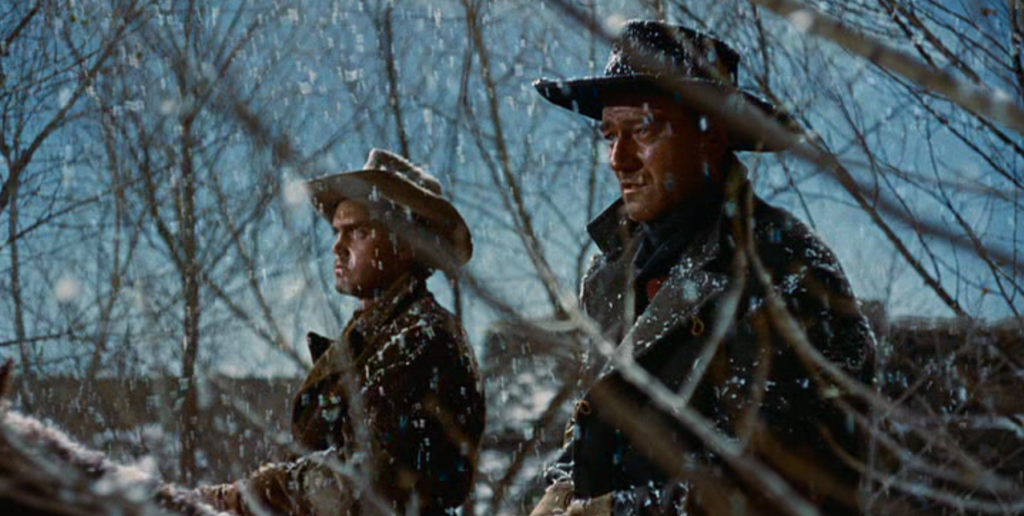
“You fit a lot of descriptions, Ethan.” — Rev. Capt. Samuel Johnson Clayton (Ward Bond)
“That’ll be the day.”—Ethan Edwards (John Wayne)
By 1956, the Western had developed into a genre capable of telling any kind of story and dealing with a wide variety of themes and moods. Postwar optimism gave way to malaise and pessimism and this was reflected in the types of stories told and themes dealt with. Young filmmakers like Anthony Mann and Samuel Fuller—and, a bit later, Budd Boetticher and Sam Peckinpah—were giving full expression to a darker vision of the American West and a more pessimistic view of those civilizing agents of Manifest Destiny. It’s not as if the Old West had changed, perhaps, but more that our idea of history and our place between civilization and wilderness in it had become more complicated.
I chose three movies for our first entries on the genre by that great Hollywood proponent of the Western, John Ford, to show that change. At the end of the Depression, with Stagecoach, Ford championed the motley denizens of the Old West—cardsharps, traveling salesmen, drunken doctors, prostitutes, lawmen—in all their obstreperous incompatibility as able to band together in moments of crisis. (Significantly for the Depression, the one actual villain of the piece, and the one who does not join the group, is a banker.)
Immediately after World War II, with My Darling Clementine, Ford presented an idealized and idyllic view of the West and gave us a legendary interpretation of one of its most famous lawmen, Wyatt Earp, as the embodiment of a simple and true sort of American hero who, like the building of a church, could represent how a frontier outpost becomes a community. (It should be noted, however, that the real Tombstone was a ghost town by the mid-1890s.)
With The Searchers, and I got this quote off Wikipedia, Ford made “the greatest Hollywood film that few people have seen.” And, in relation to Ford’s previous Westerns—and some that post-date it—The Searchers is the director’s most subtle and troubling depiction of the Old West and the Western Hero; so much so that even those people who saw the film in its original release, or those that see it today, kinda miss(ed) how complex and deeply unsettling a tale this is between Ford-usual bouts of good-natured fisticuffs, fun heavy drinking, and knee-slapping rural humor.
Beautifully filmed, as always, in Ford’s beloved Monument Valley in Utah—though its actual setting is west Texas, with forays into New Mexico and Arizona—a quest undertaken to recover a young girl kidnapped by a roaming tribe of renegade Comanches becomes a years-long and relentless pursuit spurred by revenge, obsession, hatred, and (it is inferred) murderous intent. John Wayne gives the performance of a lifetime as Ethan Edwards—the ex-Confederate soldier, outlaw, wildman, and suspected thief and murderer—who is hellbent on recovering his kidnapped niece (Natalie Woods)—and quite possibly “putting a bullet in her head” when he finds her.
Restrained only by his young half-Cherokee traveling companion (Jeffrey Hunter), we see sudden violence erupting when he shoots out a dead Comanche’s eyes or at retreating enemies or even at a herd of buffalo that might be his quarries’ food. From the longing glances at his brother’s wife in the opening scene to the famous ending shot—where Edwards, having restored his niece to the “blessings of civilization,” stands in the doorway, finds himself unable to enter, and walks away back into the wilderness—this is a story whose meaning and import is told entirely visually. As such, and though I have only begun to hint at its complexity in a too-brief 1000+ words here, this is a Western whose breadth and scope definitely requires the benefit of multiple viewings.
A long favorite of New Hollywood filmmakers like Martin Scorsese, Steven Spielberg, and George Lucas—who all visually-quoted and even partially remade this film— The Searchers remains Ford’s darkest vision of the Old West and the one viewers keep coming back to.
Westerns: early 1960s
Our first, John Ford-heavy first entries give way, like our mid-period discussion of film noirs last week, to a period of transition. As the ’50s progressed, the vast majority of Westerns being produced in Hollywood were not for the silver screen, but rather for the little boxes sitting in the nation’s living rooms. Entertaining as such TV series as Marshall Dillon, Wanted: Dead or Alive, and Have Gun, Will Travel were, they of obvious necessity lacked the breadth and scope—the startling vistas—of their more cinematic brethren.
However, TV did have one major advantage over movie Westerns by focusing, with equally obvious necessity, on more small-scale and intimate dramatic situations.
Inspired by the competition of TV, perhaps, movie Westerns became more ambitious and complex in their delineation of the Lone Western Hero and his place in the historical period of the Old West.
These mid-period selections come from the early ’60s and, while being firmly in the tradition of Westerns of the past, alter, and in some respects improve on the old formulas of a man, his horse, and his gun.
IV. RIO BRAVO (1959, Warner Bros., dir. Howard Hawks)
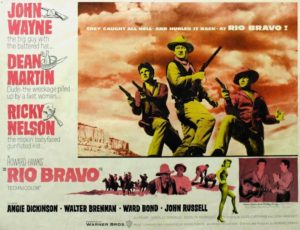 Private Diary of Sheriff John T. Chance (John Wayne); UNDATED…
Private Diary of Sheriff John T. Chance (John Wayne); UNDATED…
Lone Texican Ethan Edwards was finally brought to justice, dying the way he lived: with a rifle in his hand and a curse on his lips. Sustaining injury above the right knee from a shell-ricochet off the desert canyon wall wherein Dude (Dean Martin)had cornered and trapped the desperado, the laurels of the day—not to mention over $500 dollars of reward money from the Wells-Fargo Co.—go to Dude’s less commonly-used cognomen of “Deputy Sheriff Lebowski” and his skilled marksmanship. Cutting short an oath invoking both God and the Devil mid-pronouncement, the outlaw Edwards was felled at a distance of 100 feet and at an upward angle of 45 degrees. He’d “met his day” at the hands of a true professional.
Upon arrival in Rio Bravo, the corpse of the late wanted man slung over his former steed, a handsome brown bay, the Deputy Sheriff and I had occasion to disarm a few more of the Burdette Brothers’(John Russell, Claude Akins) men stirring up trouble in front of the Hotel Bountiful. Marching a trio of ‘em down the thoroughfare, and followed by a horse carrying a dead man, it occurred to us that we’d soon have words of a distinctly wheezing, wheedling nature from our friend at the jail, ol’ Stumpy(Walter Brennan), about this most untoward “delivery”!
Rounding the corner, and dissuading Dude with a firm hand on his reins from veering off to the saloon for a “quick one”—which, increasingly of late, would end up with him face-down in a trough at sunup—brought back with unwelcome immediacy the troubles of the town, where Dude was quickly earning the nickname among the rougher elements of “Borrachón.” Spanish for “drunk.” A sidelong glance by Dude as we passed the Gem Theatre, resting on a playbill for one of the feather-festooned denizens of the evening, reminded me further of some words of wisdom from an old Colorado trail-hand of my acquaintance, fellow name of Ryan:
“Women. Don’t have nothin’ to do with ‘em more’n ya need.”
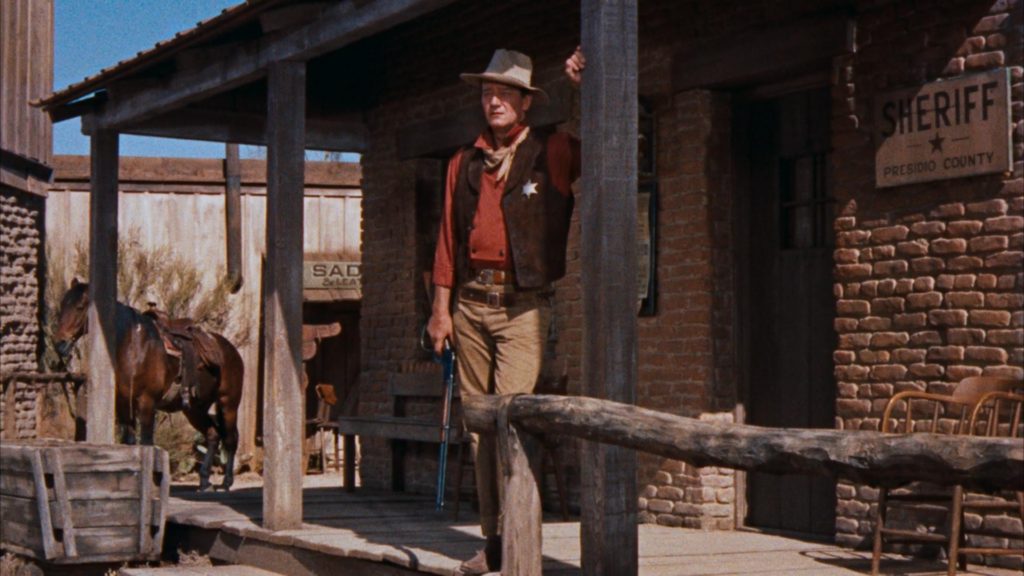
“We’ll remember you said that.”
Very few directors of Hollywood genre pictures earned the distinction of working in so many varied genres with such continued success as director Howard Hawks. From the waning days of the silents to his final 1970 Western Rio Lobo, Hawks, in-between, one-upped the gangster flick with the then-extreme violence of Scarface (1931), invented and refined the Screwball Comedy (1934’s Twentieth Century, 1938’s Bringing up Baby, 1940’s His Girl Friday), out-did the wartime melodrama ofCasablanca with Bogie and Bacall in To Have and Have Not (1944), brought them back for one of the great film noirs, 1946’s The Big Sleep, and even made a musical with the two great screen sirens of the day, Jane Russell and Marilyn Monroe, in 1953’s Gentlemen Prefer Blondes. It was relatively later in his career that Hawks finally attempted a Western, 1948’s John Wayne-starring Red River, but when he did, Hawks brought the same professionalism, character-types, economy of style, and thematic concerns that had marked his aviation pictures, war films, and other genre fare; in other words, Hawks took a commercially-proven formula, improved on it, and marked it with his own personal stamp of “professionalism.”
Frequently singled out as one of the “three greats” of Classic Hollywood Filmmaking—a short-list that also includes fellow notable independent producer/directors John Ford and Alfred Hitchcock—the truly remarkable feature of a Hawks’ film is how artless his art first appears. And nowhere is that in greater evidence than his second Western, appearing 11 years after his first, 1959’s Rio Bravo. Ostensibly made in response to or as an inversion of the basic plot to High Noon (1952)—where a Western sheriff responds to the threat of a siege by outlaw elements not by calling on the help of inexperienced townspeople but rather by relying on a small group of well-trained “professionals”—the elements of the “standard Western” are laid so entirely bare, and the setting and situations so generalized among other boilerplate horse operas, that one could conceivably enjoy Rio Bravo‘s 141 minutes of stakeouts, shootings, and singing (the lattermost being kinda hard to avoid when you’ve got two of the biggest recording artists of the day, Dean Martin and Ricky Nelson, in the cast) while not noticing anything too remarkably special about the proceedings.
Instead, upon further consideration of its apparently artless qualities, what one takes away from Rio Bravo is a genre picture that simultaneously embodies and transcends its genre trappings. A brief inventory reveals a depth of unmatched storytelling as profound as it is unobtrusive through the rigorous care with which every character and each plot element is presented: “Colorado Ryan” (Ricky Nelson), the young and able gunslinger, offers his help to Sheriff Chance after his boss, “Pat Wheeler” (Ward Bond), is shot and killed, but that help is not accepted until his own life is threatened by recklessly “throwing in” (quite literally, through the agency of a flowerpot through a window) with Sheriff Chance; Dude, AKA “Borrachón,” redeems his fall from grace as the town drunk by slowly-but-surely regaining his skill with the gun, thus reasserting his position, and more importantly his identity, as Sheriff’s Deputy; stagecoach visitor “Feathers” (Angie Dickinson), the proverbial “woman with a past,” turns the head of the hard-headed (and hard-hearted) Sheriff by first confusing his expectations about what “that type of woman” should be, and then matching him verbal spar-for-spar in a courtship ritual as suggestively “disarming” as it is entertaining.
Not only does everything happen for a reason in a Howard Hawks movie, everyone acts according to his or her reason; the internal consistency of the film’s faultless construction presenting time-honored themes (and distinctly Hawksian concerns) such as skill, honor, respect—even love (but, notably, love based on mutual, equally-earned respect)—in an admirably invisible, artfully-artless style.
In closing, whether it was a racing picture, seafaring adventure, or a wacky comedy, Howard Hawks among all other Classical Hollywood directors best personified the notion of “unselfconscious filmmaking”: with Rio Bravo, then, as good a Classic Western as could be conceivably made.
Westerns: mid-1960s – “present day”
Despite a previously-stated aversion to non-classical elements in Westerns, our final selections from the late 60s into the 1970s (and beyond) destroy those larger-than-life myths and legends surrounding figures like Billy the Kid (a brutal, sadistic murderer), Jesse James (an even more brutal, sadistic murderer), Buffalo Bill (a cheap, if flamboyant, opportunist), Wild Bill Hickok (a gambler and a drunk), John Wesley Hardin (an out-and-out psychotic)… the list goes on!
To wit, General George Armstrong Custer: Civil War hero and martyr at Little Big Horn OR vainglorious agent of American imperialism and genocide?
That a double-viewing of Errol Flynn in Raoul Walsh’s hero-worshipping They Died With Their Boots On (1941) and Richard Mulligan in Arthur Penn’s idol-smashing Little Big Man (1970) is possible, if not advisable, suggests that not only does our perception of history change over time, but that history itself “changes” when new information comes to light, or is seen in a different way.
Rounding up our discussion on uniquely American genres of filmmaking, our final entries will explore that “difference” in terms of both content and presentation—or, in more cinematic terms, “narrative and style”—in three outstanding examples of what I feel, as a long-time admirer of the genre, add depth and scope to one’s appreciation of the historical period of the American West and its artistic reflection, the Western.
V. RIDE THE HIGH COUNTRY (1962, MGM, dir. Sam Peckinpah)
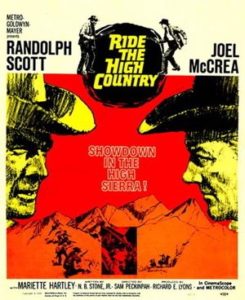 Bible-Diary of Steve Judd (Joel McCrea), Lawman; Year of Grace, 1907…
Bible-Diary of Steve Judd (Joel McCrea), Lawman; Year of Grace, 1907…
“Sufficient unto the day is the evil thereof.” (Matt. 6:34) I have chosen this verse to express the sense of foreboding upon my tenth and final-day approach on the town of Hornitos, nestled in the ever-looming shadow of the High Sierras. Possibly Psalms 23:4 would be more appropriate here, come to think of it, but even as my hand grips the worn reins of my tired steed, and the hot leather of the stirrup rubs my foot raw through a silver dollar-sized hole in my boots, I cannot deny the beauty and majesty of these rolling green plains and the snow-peaked mountains on the horizon. Truly, this is God’s Country. But it comes with a price as these same heavenly perches framing the distance are mined for their earthly treasures and Coarse Gold—which also doubles as the name for the mining camp whose shipment the bank has dispatched me to protect—inspires murderous intent. Six men, to be exact, ruthlessly gunned down for having heedlessly attempted to transport The Color out of these mountains to the town. Victims of that “false glister” that so tries man’s immortal soul. And I will be goddamned if one more among them falls to it.
“One generation passeth away, and another generation cometh: but the earth abideth for ever.” (Ecc. 1:4) This comes firmly to mind after enlisting the aid—to the amount of one-third of the bank’s stake—of an old friend of mine, out of Wichita, the Ozarks, and that business in Lincoln County, Gil Westrum(Randolph Scott). Caught him at a carnie fair pulling some hoodwink on the local yokels, dressed up like Buffalo Bill and calling himself The Oregon Kid, or some such nonsense! Hell, there isn’t one among us old-timers who haven’t felt the bite of these amalgamated, automated, automotive days, but the vested interests will still call on the likes of Gil Westrum and Steve Judd when some good ol’ fashioned pistol-packing, horse-riding, quick-thinking law and order is needed. Not at all certain about this saddle pal of Gil’s though, young buck by the name of Heck Longtree (Ron Starr), but I suppose it’s natural for an older generation to distrust the generation that comes after it. Even Gil seems tainted in some way through the distance of twenty-odd years; hard-edged and glib, like I’d be a damned fool to trust him any further’n I could spit. But God knows I’m not approaching my fifty-seventh winter by entering the mountains on my lonesome. We saved each others’ lives once; let’s hope some things—friendship, loyalty, and honor—remain eternal.
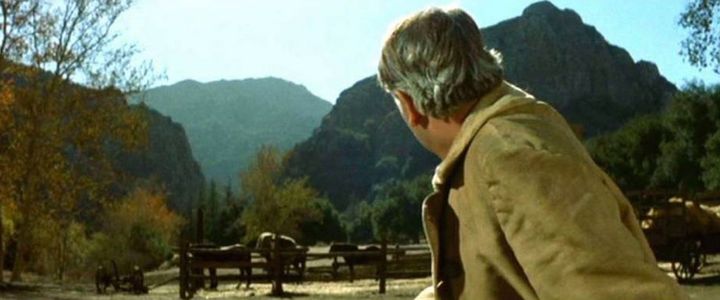
“All I want is to enter my House justified.”
In his 1872 Western memoir Roughing It, author Mark Twain identified three print works a visitor would be sure to find on the shelves of any humble Western abode: John Bunyan’s 1678 Christian allegory Pilgrim’s Progress, The Complete Works of William Shakespeare, and The King James Bible. The poetic, morally-elevated language of seventeenth-century English, it seems, suffused and permeated the imagination of white settlers regarding the American West of the nineteenth century in much the same way that movies held a vaunted cultural cache for Americans during much of the twentieth century (and, I suppose it goes without saying, the internet does for the twenty-first). So if an exchange between the daughter, “Elsa Knudsen” (Mariette Hartley), of a Bible-thumping farmer (R.G. Armstrong) and the devout, aging lawman Steve Judd holds any significance beyond the bare content of its words—ie., “My father says there’s only right and wrong – good and evil. It isn’t that simple, is it?” “No, it isn’t. It should be, but it isn’t.”—it’s that the conversation is taking place in the early twentieth century and that the days of the Wild West are both literally and figuratively over. (That the girl’s father will soon lie slung over a fence next to his wife’s grave a scant few yards away from the conversationalists with a bullet through his eye—a giant crow perched on his shoulder pecking at the fatal wound—certainly doesn’t hurt the argument.)
From its opening image of a now-elderly, threadbare saddlebum mistakenly thinking that the parade as he arrives in town is for him, and then soon after being pushed out of the street by a speeding motorcar(!), Ride the High Country almost immediately announces itself as a post-Western. Director Sam Peckinpah, whose second film Western this was after a decade working on the TV WesternsGunsmoke, Have Gun, Will Travel, and The Rifleman, made his subsequent career in celebrated Westerns like The Wild Bunch (1969), The Ballad of Cable Hogue (1970), and Pat Garrett and Billy the Kid (1973)—even non-Western, contemporary thrillers like The Getaway (1972) and Bring Me the Head of Alfredo Garcia (1974) somehow still seemed like Westerns—on the passing of the Western era and, with it, the values and worldview that perpetuated it. Released in 1962, the film comes at a transitional point for Peckinpah, where his trademarked ‘orgy of blood-letting’—with its jaggedly-edited, quick-zooming, slow-motion action sequences—was still seven years in the future; but though the classical, stately images of mountains and woodland scenery (beautifully photographed by Lucien Ballard) may still look and seem “traditionally Western,” the dialogue and dramatic action plays even more effectively as an elegy mourning its death.
Brilliantly cast, with aging Western stalwarts Joel McCrea and Randolph Scott (in his final film appearance) playing against a soon-to-be-emerging New Hollywood element in actors like Warren Oates and L.Q. Jones—absolutely frightening as two of their “un-Reconstructed, redneck peckerwood” antagonists (a clan of evil backwoods brothers most distinctly un-Seven Brides for Seven Brothers-like!)—Ride anticipates such genre-shattering, revisionist fare as the Spaghetti Westerns of Sergio Leone (The Good, the Bad, and The Ugly [1966], Once Upon a Time in the West [1968]) and Peckinpah’s own later body of work, while simultaneously honoring the traditional movie Western values celebrated in the films of John Ford, Howard Hawks, and others. However, as the last word on the subject, where the fatally-wounded hero drops out of frame in the final image to reveal the mountain range standing impassively in the background, the meaning is clear: it’s not just a man who has passed from this world, but also a country, a way of life, and a legend.
VI. McCABE AND MRS. MILLER (1971, Warner Bros., dir. Robert Altman)
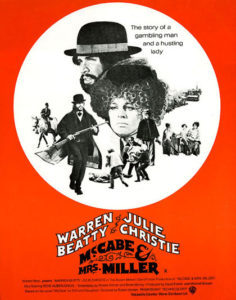 Advert appearing in various Northwestern newspapers, ‘round the turn of the 20th century…
Advert appearing in various Northwestern newspapers, ‘round the turn of the 20th century…
“WANTED: Clean, upright, hard-working young women to serve off-hour needs of clean, upright, hard-working young men in frontier mining town. Presbyterian Church is a God-fearing community nestled in the snow-peaked hills of the Pacific Northwest, for which ‘McCabe’s’ aims to fulfill the function of entertainment, diversion, and leisure. Lots of scope in these hills for young ladies of ambition and enterprise. Interested parties answering to this description please respond to ‘John McCabe’ (Warren Beatty) in care of Sheehan’s Saloon, Presbyterian Church, Washington state.”
Letter received two weeks later by McCabe at Sheehan’s…
“Intrigued by advert appearing in Sunday edition of Spokane Inlander. Particularly mention of ‘scope.’ Been in trade since age of 15 and have had experience of a supervisory capacity in Oklahoma, Arizona, and the Dakotas. Arriving at Bearpaw Depot from Spokane on Wednesday the 24th of this month on evening run of the Northwest Limited. Sincerely, ‘Mrs. Constance Miller’ (Julie Christie)”
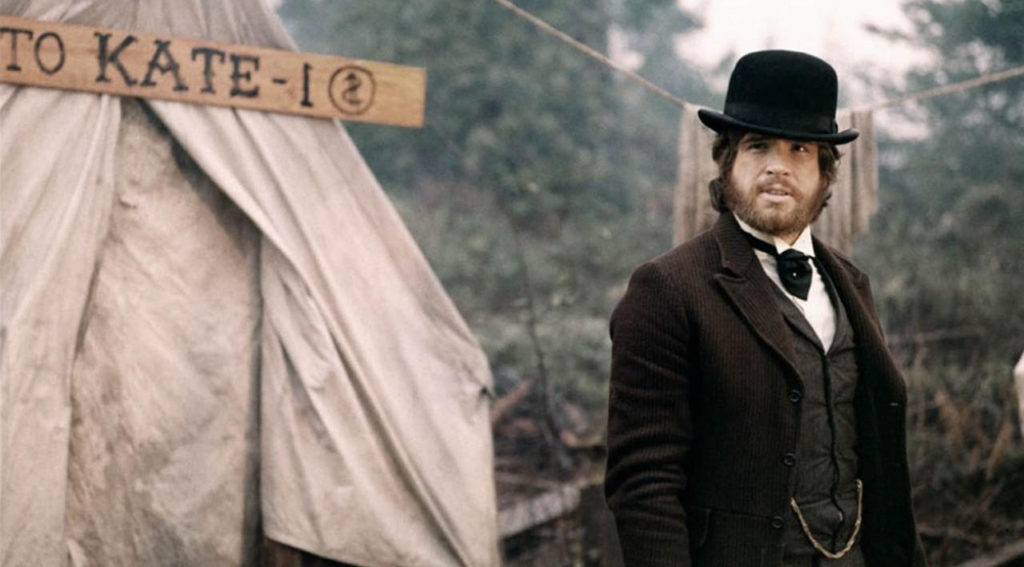
“If a man is fool enough to get into business with a woman, she ain’t going to think much of him.”
Well, the bare-bones story of an inveterate gambler, tall tale-teller, and habitual liar—“McCabe,” played with false bravado and affable cluelessness by Warren Beatty—settling in a piss-poor mining town, buying a few ‘contracts’ off a local pimp, and setting up a makeshift frontier brothel doesn’t initially seem to offer much in the way of ‘scope.’ Until an ambitious, hard-as-nails Western (by way of East London) ‘madam’—“Mrs. Miller,” played with forceful directness and pitiless drive by Julie Christie—arrives to set things ‘a course, that is, and to lend direction and interest to an otherwise ‘bald and unconvincing narrative.’
One the dreamer and the other the doer, their ‘business’ flourishes along with the rising fortunes of the community—perversely named “Presbyterian Church” after the one building its denizens never frequent—and eventually attracts the amalgamated interest of an eastern mining company that deals only in terms of money or death. Like a later Robert Altman picture, his bicentennial-era masterpiece Nashville (which I hope to profile in a few months), we can add the addendum that it all ends the only way it can when small interest and big business collide: Only in the West! Only in America!
…
But we’re getting a bit ahead of ourselves, I fear. The story, while amusing enough, *might* not be enough to hold one’s attention for a solid 2 hours if it were not for the style of its telling. Conceived by its director as an “anti-Western,” the off-kilter photography (by Vilmos Zsigmond), music (from Leonard Cohen’s debut album), and performances (professional and non-professional alike) create a unique feel and mood unlike any movie made before and after (unless you count any other movie made by Robert Altman, I suppose), to say nothing of any Western.
Much as one can appreciate the conventions of the genre and its historical development to this point—from one-reel shoot-‘em-ups made in the early teens to the out-sized epic vision of a John Ford or Sergio Leone—one also can’t help feeling something had been missing in almost every depiction of the Old West heretofore: its reality. Here, the naturally over- and under-lit images (yellow candlelight and kerosene lamps in one scene, but blazing orange and sun-filtered in the next); the verisimilitude of the performances (staged in the chaotic hurly-burly of the everyday, with characters cross-talking over, under, or all-at-once); and the seemingly aimless nature of the plot (nonetheless focusing at crucial moments in alternately hilarious or devastating fashion, much like the wandering camera that punctuates each scene with telling zoom-ins or track-outs)… All make for an unusual and genre-bending viewing experience in which one occasionally forgets one is even watching a Western; rather, one feels at times in watching McCabe and Mrs. Miller that one is actually seeing the Old West.
Rambling and off-focus as the film’s style and narrative might be—not to mention its chief aesthetic—it’s also kinda the point. Send a filmmaker back in time with a camera, crew, and performers, shoot the result—carving a little piece of filmmaking out of a still-untamed corner of the American wilderness—and you might end up with something close to this movie. In other words, as close as a narrative film can get as to what perhaps the Old West was really like.
VII. HEAVEN’S GATE (1980, United Artists, dir. Michael Cimino)
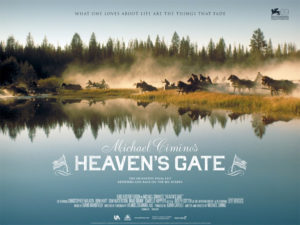 Harvard, 1870; the night-terrors of graduate and commencement speaker, William C. “Billy” Irvine (John Hurt)…
Harvard, 1870; the night-terrors of graduate and commencement speaker, William C. “Billy” Irvine (John Hurt)…
A vision of Wyoming! Divorced of context, devoid of meaning, a jumble of images appear as if projected on the interior of my mind’s eye! The first: smoke clears on the horizon, a hanging curtain tears asunder, a jagged slash of blood stains the white sheet red, and the sharp features of a man gripping a double-barreled shotgun (Christopher Walken) emerges through the haze, framed against snow-peaked mountains in the far distance. The second: my old friend Jim Averill (Kris Kristofferson)sits in the train compartment of a sleeper car, the light of daybreak streaming through the window; careworn, bearded, grizzled, aging. The third: a woman on horseback (Isabelle Huppert) gallops blood-and-thunder through a fire-and-guts display of raging battle, circling the wagons of an impenetrable Union barricade of smoke and dust like a veritable Athena, an Amazonian of legend. The fourth: a rail-skinny young man with a fringe of brown curls poking under his hat (David Mansfield) circles a dance floor on roller skates, a fiddle under his chin playing in an ever-mounting frenzy of intensity; with each pass the polyglot of Russian, Czech, and Polish tongues in attendance rise in admiration until a bearded man—the establishment’s proprietor, presumably (Jeff Bridges)—leans out the entrance way to vomit forth a day’s worth of whiskey in equal dry heaves of admiration, directly under a sign that reads “Heaven’s Gate.”
A tale not easily told, perhaps, or readily understood even, but oh, what lovely visions!
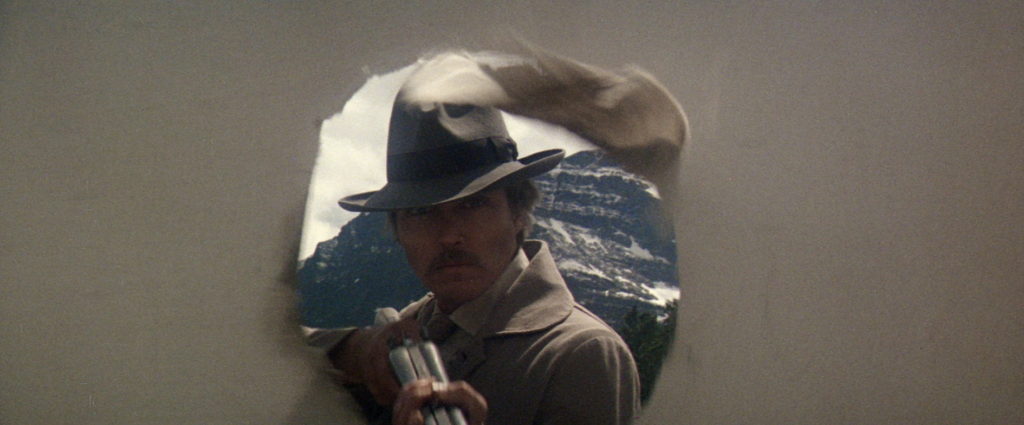
“Do you know what I really dislike about you, Jim? You’re a rich man with a good name. You only pretend to be poor.”
Okay: any attempt to address—or, God forbid, defend—what has come to be known as the most Infamous Movie Disaster of All-Time will inevitably fall into the critically-specious category of apologia. So, foregoing a lengthy discussion of a film that is credited with bankrupting an entire studio (United Artists), destroying a once-promising filmmaker’s career at the height of his talent and renown (Michael Cimino), and, finally, dissuading major producers over the next decade from making many, if any,movies in the only truly American genre of filmmaking (the Western), I have come not to bury Heaven’s Gate, two words that have become synonymous in the Hollywood community with “colossal failure,” but to praise it. In short, the legends that have grown around this epic-of-all Westerns—everything from allegations of extreme animal cruelty to tearing down and re-building an entire Western town just because “it didn’t look right”(!)—have overshadowed the film’s truly legendary qualities as a dream-vision of the American West and an incisive criticism of its Manifest Destiny.
Based, with a good deal of justifiable artistic license, on the Johnson County War of early 1890’s Wyoming—a series of historically bloody battles between wealthy, corporate ranchers and homesteading, small farmers—the film distills the historical record to its essence as a conflict of the landed interests, represented by a coterie of effete Eastern speculators playing billiards in a gilt-edged, luxurious drawing room, against the “hordes” of Eastern European immigrants streaming into God’s Country, forced into make-shift hovels and crammed into tenement-style backrooms. Accused almost immediately upon settling of thievery, whoring, and (gasp!) intemperance—with some justification on all counts, admittedly—the scandalized members of society’s upper-crust declare all-out war on these “unwashed” foreigners and draft a draconian “death list” that gains, in succession, the support of an armed militia, the backing of the governor of the (recently-admitted) state of Wyoming, and, finally, the endorsement of the standing U.S. President and the direct enforcement of the U.S. Army.
The premise, baldly-stated, is pretty much the ultimate in popular movie-making revisionism—the culmination of a cinematic re-evaluation of historical events that began in the late ’60s with Arthur Penn’s Bonnie and Clyde (1967) and continued through films like Penn’s later Little Big Man(1970), Robert Aldrich’s Ulzana’s Raid (1972), and Sam Peckinpah’s Pat Garrett and Billy the Kid(1973)—but would gain nothing over its predecessors if not, like MCCABE AND MRS. MILLER before it, for the manner of its telling. With Heaven’s Gate, director Michael Cimino scaled ambition heretofore unseen on the silver screen, joining the ranks of Erich von Stroheim’s Greed (1924), Orson Welles’ The Magnificent Ambersons (1942), and Peckinpah’s earlier Major Dundee (1965) as a “misunderstood,” seemingly-botched near-masterpiece of narrative innovation and artistic exploration. Pardon the poetic revery in advance but, as the subject and manner of its expression seems to call for it (see Billy Irvine’s purposely-bewildering “plot description” again), one could say that the twentieth century “dreamed” and, through a medium that uniquely combined commerce, art, and technology, out came “movies”: from folk music fiddled on roller skates to a snowscape covered in crimson blood to a bullet-ridden siege on a lonely cabin, Heaven’s Gate shows us scenes, images, and, yes, even “visions” that re-define and re-shape an audience’s perception of and relationship to a then-80-year-old movie genre, the Western.
Despite the movie’s well-documented financial, artistic, and even legal transgressions, what matters in the end is what’s up on the screen and, whatever one’s reaction to it, I defy a single viewer to come away from Heaven’s Gate in its full, re-mastered 216-minute cut unaffected!
[NOTE: For my final Western write-up, and, indeed, the final entry on this 4-part series on “American Genres,” I am faced with two difficulties: first, I have chosen to end with a TV show when I am ostensibly writing about movies and, second, the TV show I have chosen—one of the best ever made, I feel—is decidedly “un-family friendly” in its content and, more particularly, in its language. We at ZekeFilm have actually discussed the first matter on our own “contributor’s page” and the consensus reached, I believe, is that acclaimed TV shows of the past two decades such as The Sopranos (1999-2007), The Wire (2002-2008), Boardwalk Empire (2010-2014), and Breaking Bad (2008-2013)—for but a few examples—are wholly and complexly cinematic both in terms of their storytelling and stylistic technique and, therefore, not only deserve but, nay, demand to be discussed in the same breath as, say, Goodfellas (1990), Heat (1995), The Godfather (1972), and Taxi Driver (1976). The second, though, is a slightly more pressing problem, especially since this IS a “family friendly”website and, in my original write-up appearing on my Facebook page in 2013, I addressed what I felt was the “inescapable” matter of the series’ language head-on, and without regard to more sensitive ears. Since the language is integral to the impact of the series, and to not address it would be a critical error, as a solution, then, I have decided to use asterisks—i.e., “f***”, “s***” , and one character’s personal favorite of “c********r”—to denote its usage.]
VIII. DEADWOOD (2004-2006, HBO,created by David Milch)
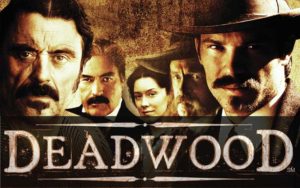 The first thing visitors noted upon entering Deadwood—driven, perhaps by Wild Bill Hickock’s old pal “Charlie Utter” (Dayton Callie), by stagecoach from Cheyenne—between 1876 (when General Custer had recently lost the Battle of Little Bighorn and western miners rushed to pre-existing gold claims illegally settled on Sioux Indian Territory) and 1877 (when the camp had since flourished due to the richness of those finds and the opportunities presented by the emerging community) was in fact the language. The mainly religious-based and profane ‘oaths’ those western miners would take ‘in vain’—as opposed to the mainly scatological and sexual-based invective we trade on today—were so shocking to ears innocently unfamiliar with profanity that, initially at least, visitors may even have neglected to note the camp’s second most notable feature circa 1876-77: its stench. Public sanitation was an unorganized and haphazard affair at best (ie., throw your buckets into the thoroughfare) until well after the town was officially annexed into the Dakota territories in late 1876. Finally, after the dust (and mud and excrement) settled on one’s stagecoach entrance into historical Deadwood, one was free to take in the lawless, intemperate, and “godless” acts of casual public violence, drunkenness, and fornication outside the establishments that then-formed the basis of the camp’s commercial center: its brothels and saloons.
The first thing visitors noted upon entering Deadwood—driven, perhaps by Wild Bill Hickock’s old pal “Charlie Utter” (Dayton Callie), by stagecoach from Cheyenne—between 1876 (when General Custer had recently lost the Battle of Little Bighorn and western miners rushed to pre-existing gold claims illegally settled on Sioux Indian Territory) and 1877 (when the camp had since flourished due to the richness of those finds and the opportunities presented by the emerging community) was in fact the language. The mainly religious-based and profane ‘oaths’ those western miners would take ‘in vain’—as opposed to the mainly scatological and sexual-based invective we trade on today—were so shocking to ears innocently unfamiliar with profanity that, initially at least, visitors may even have neglected to note the camp’s second most notable feature circa 1876-77: its stench. Public sanitation was an unorganized and haphazard affair at best (ie., throw your buckets into the thoroughfare) until well after the town was officially annexed into the Dakota territories in late 1876. Finally, after the dust (and mud and excrement) settled on one’s stagecoach entrance into historical Deadwood, one was free to take in the lawless, intemperate, and “godless” acts of casual public violence, drunkenness, and fornication outside the establishments that then-formed the basis of the camp’s commercial center: its brothels and saloons.
The West was wild and, somehow, Deadwood—an illegal settlement on Indian land, organized around and subject to “the color” (i.e., gold)—managed to be wilder.
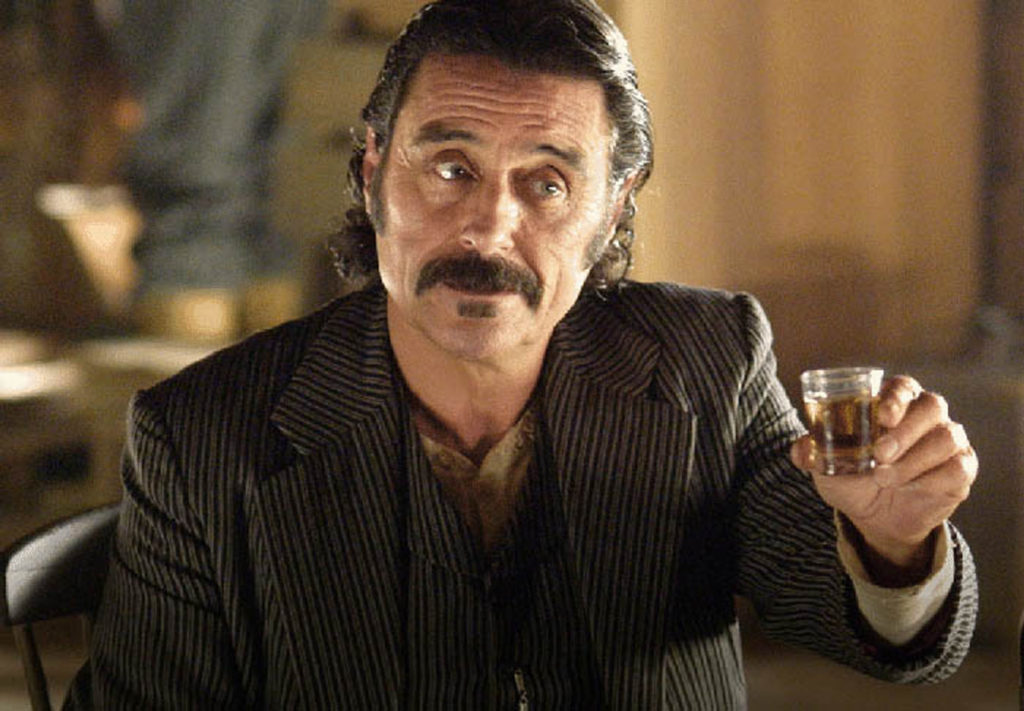
“How does Hearst hope to defeat me?… Allied as I am with the imbecile, the contemptible, and the promiscuous f***ing insane.”
“Welcome to f***ing Deadwood!”
So, back in those Wild Western days of yore, “Did they speak that way then: f***, and the like?” Well, no. But somehow one imagines the more period-accurate curses of “consarn it!”, “yellowbellied varmint,” and “peckerwood hornytoad,” to lack the same *bite* to modern ears as, say,”be f***ed!”, “loopy c***,” and, my personal favorite, “pie-faced c*******r.” The actual historical Deadwood, as hotelier and first Mayor “E.B. Farnum” (William Sanderson) so memorably puts it, was a “godd****d quagmire of piss and bulls***.” Both literally and figuratively.
Did future Deadwood sheriff “Seth Bullock” (Timothy Olyphant) ever meet “Wild Bill Hickok” (Keith Carradine) before his untimely end in the No. 10 Saloon, grasping Aces over Eights in his “dead man’s hand”? Did mining emperor “George Hearst” (Gerald McRaney), he of the Comstock Lode in Colorado, actually visit Deadwood to oversee the acquisition of what would become the Homestake mine, the largest gold find in American history? Was “Al Swearengen” (Ian McShane) even proprietor of the Gem Saloon during the time period of this historical drama? No, no, and no.
But why should slavish devotion to accuracy get in the way of a deeper historical truth? And here, in David Milch’s brilliant re-interpretation of the historical record, that deeper issue is one of dramatic effect.
The dramatic arc of the series details how one Western American town was founded, hearkening back to the time-old Western theme of building community out of the wilderness, and concerns itself with the effect of that growth on the individuals in the community; whether they be lawmen (Seth Bullock, Wild Bill Hickok), business owners (Sol Star, Charlie Utter, Joanie Stubbs), miners and proprietors (Alma Garrett, Ellsworth), fringe outsiders (Calamity Jane, Trixie the Whore, Mr. Wu), public servants (A.W. Merrick, Doc Cochran), “servants of God” (Rev. Smith, Rev. Cramed), or “purveyors of sin and filth” (Cy Tolliver, Al Swearengen).
Obstreperous once more in their incompatibility—much like the representative denizens of the Old West profiled in the very first of this series of write-ups, Stagecoach—they nonetheless do band together by the end of the series against the amalgamated and capitalized interests represented in that monstrous “leviathan” of American greed and self-interest, George Hearst.
That they lose is a foregone conclusion, but it’s the endearing cooperation that’s portrayed through the course of the series—how public institutions are formed; how strong personal relationships are forged; and, most astonishingly, how the initial villain of the piece, saloon owner and cutthroat murderer Al Swearengen, becomes the protecting hero of them all!—that gives this Western series its dramatic thrust.
[::SPECULATIVE SPOILER::The show was not renewed for a fourth season, and therefore could not tie up many of its loose-end storylines, but here’s how I think Deadwood would have ended: Al Swearengen, at a low point due to his failing interests, and unable to further protect those who have come to depend on him, follows actual history and burns down the camp. (Swearengen consistently mentions this as an option of last resort throughout the series.)::SPOILER ENDS::]
Profane, shocking, challenging; sure. But despite its difference, I think this drama gets its power precisely because it’s a Western, and I think Deadwood is firmly in the tradition of Westerns of old. When the show was on, I heard too many people saying that they “like[d] the show despite it being a Western,” or observing that “the show is much better than a Western.” Balderdash! Rather,Deadwood is like a Western written by Shakespeare—the poetic and elevated language alone, despite its frequent recourse to broad Anglo-Saxon, would mark it along those lines—in which age-old traditions and characters are drawn out and explicated on the broadest of all canvasses: as a map of the human soul. Its themes are universal, and so are a Westerns’: a truly homegrown and distinctly American genre of fiction and legend.

